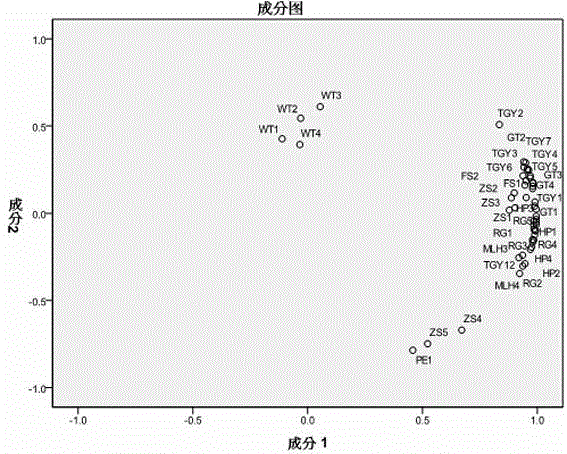Method for identifying tea species and determining contents of 21 characteristic components
A tea content technology, applied in the field of analytical chemistry, to improve the separation, save testing time and cost, and benefit the quality control of tea
- Summary
- Abstract
- Description
- Claims
- Application Information
AI Technical Summary
Problems solved by technology
Method used
Image
Examples
Embodiment 1
[0030]Weigh 1.0000g of 52 tea samples and pulverize them evenly, or freeze them in liquid nitrogen for 60s, take them out, and smash them quickly. Use 50wt.% ethanol solution for ultrasonic extraction for 20min, add water to 50mL, and centrifuge at 5000rpm / min. The supernatant was filtered through a 0.22 μm organic filter membrane and set aside. The 21 characteristic components are theanine, gallic acid, gallic acid catechin (GC), caffeine, theophylline, epigallocatechin (EGC), catechin (C), chlorogenic acid, cocoa Alkaline, caffeic acid, p-coumaric acid, epicatechin (EC), epigallocatechin gallate (EGCG), gallocatechin gallate (GCG), epicatechin gallate (ECG ), rutin, ferulic acid, sinapinic acid, myricetin, quercetin, kaempferol. The conditions of the high performance liquid chromatography-diode array detector method are as follows: C18 chromatographic column is used, the column temperature is 30°C, and the mixture of acetonitrile and 0.5wt.% formic acid solution is used as ...
PUM
 Login to View More
Login to View More Abstract
Description
Claims
Application Information
 Login to View More
Login to View More - R&D
- Intellectual Property
- Life Sciences
- Materials
- Tech Scout
- Unparalleled Data Quality
- Higher Quality Content
- 60% Fewer Hallucinations
Browse by: Latest US Patents, China's latest patents, Technical Efficacy Thesaurus, Application Domain, Technology Topic, Popular Technical Reports.
© 2025 PatSnap. All rights reserved.Legal|Privacy policy|Modern Slavery Act Transparency Statement|Sitemap|About US| Contact US: help@patsnap.com



